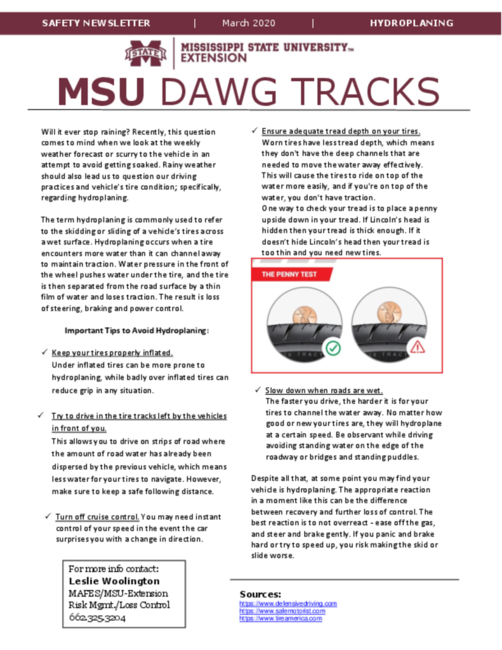Dawg Tracks Safety Talk
Hydroplaning
Will it ever stop raining? Recently, this question comes to mind when we look at the weekly weather forecast or scurry to the vehicle in an attempt to avoid getting soaked. Rainy weather should also lead us to question our driving practices and vehicle’s tire condition; specifically, regarding hydroplaning.
The term hydroplaning is commonly used to refer to the skidding or sliding of a vehicle’s tires across a wet surface. Hydroplaning occurs when a tire encounters more water than it can channel away to maintain traction. Water pressure in the front of the wheel pushes water under the tire, and the tire is then separated from the road surface by a thin film of water and loses traction. The result is loss of steering, braking and power control.
Important Tips to Avoid Hydroplaning:
- Keep your tires properly inflated. Under inflated tires can be more prone to hydroplaning, while badly over inflated tires can reduce grip in any situation.
-
Try to drive in the tire tracks left by the vehicles in front of you. This allows you to drive on strips of road where the amount of road water has already been dispersed by the previous vehicle, which means less water for your tires to navigate. However, make sure to keep a safe following distance.
- Turn off cruise control. You may need instant control of your speed in the event the car surprises you with a change in direction.
- Ensure adequate tread depth on your tires. Worn tires have less tread depth, which means they don't have the deep channels that are needed to move the water away effectively. This will cause the tires to ride on top of the water more easily, and if you're on top of the water, you don't have traction. One way to check your tread is to place a penny upside down in your tread. If Lincoln’s head is hidden then your tread is thick enough. If it doesn’t hide Lincoln’s head then your tread is too thin and you need new tires.
- Slow down when roads are wet. The faster you drive, the harder it is for your tires to channel the water away. No matter how good or new your tires are, they will hydroplane at a certain speed. Be observant while driving avoiding standing water on the edge of the roadway or bridges and standing puddles.
Despite all that, at some point you may find your vehicle is hydroplaning. The appropriate reaction in a moment like this can be the difference between recovery and further loss of control. The best reaction is to not overreact - ease off the gas, and steer and brake gently. If you panic and brake hard or try to speed up, you risk making the skid or slide worse.
